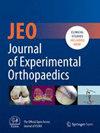Cementless unicompartmental knee arthroplasty is safe and effective at a minimum follow-up of 4.2 years: A systematic review
Abstract
Purpose
Cemented unicompartmental knee arthroplasty (UKA) is a widely used procedure in the treatment of anteromedial and lateral knee osteoarthritis. However, several advantages are reported for cementless UKA, such as improved osseointegration, reduced cement-related costs and complications. The aim of this study was to analyse clinical outcomes, survival, complications, failures and revision rate of cementless UKA.
Methods
A systematic review was performed on 31 May 2024, on PubMed, Cochrane Library and Scopus. We included randomised clinical trials and prospective and retrospective studies reporting clinical outcomes, implant survival, complications, failures and revision rates of cementless UKA. The following data were extracted: study design, type of implant, number of patients and knees, follow-up, age, sex, pre-operative and post-operative clinical outcomes, reoperations and revisions with causes of failure and overall survival.
Results
Fifteen studies were included, involving 3475 patients and 3641 UKA (2568 cementless UKA and 854 cemented UKA). The mean patients' age was 66 years. The mean follow-up was 6.5 years. The Oxford Knee Score improved from 17.8 preoperatively to 40.3 post-operatively in cementless UKA. Knee Society Score improved from 118.2 preoperatively to 168.6 post-operatively in cementless UKA. The reoperation rate was 3.85% for cementless UKA and 9% for cemented UKA. The most common causes of revision were osteoarthritis progression (1.4%), aseptic loosening (0.8%), bearing dislocation and unexplained pain (0.7%). The overall survival of cementless UKA was 96.2% and 93.6% at 5 and 10 years, respectively.
Conclusion
Cementless UKA is a viable alternative to cemented UKAs with a low failure rate, without a lower clinical benefit at a minimum follow-up of 4.2 years.
Level of Evidence
Level III, systematic review of studies.


 求助内容:
求助内容: 应助结果提醒方式:
应助结果提醒方式:


